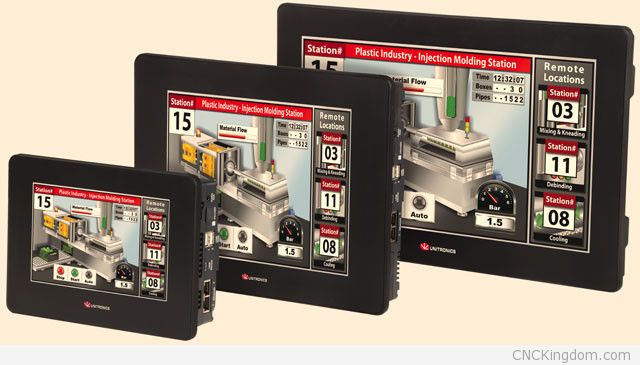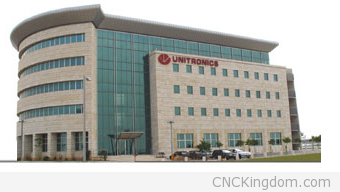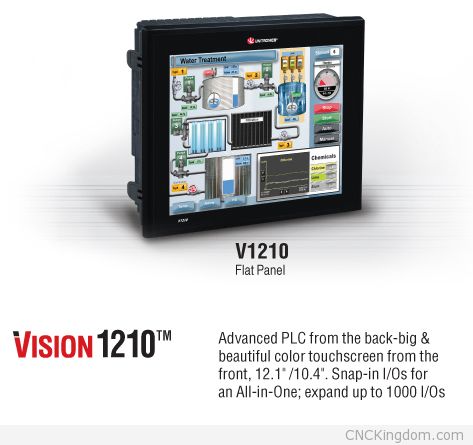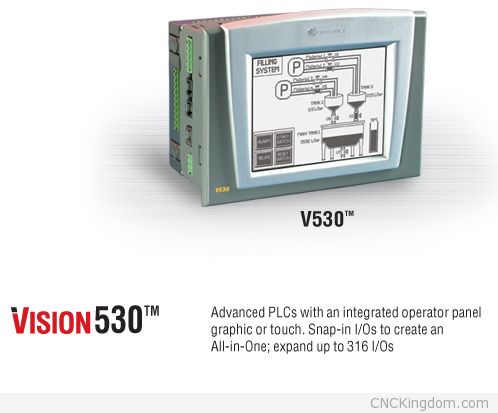Molly Rodin from Unitronics, Inc (Israel/USA)
Manufacturing is an endlessly fascinating field to me – especially in the industrial vertical. Here’s an interview I had with Molly from Unitronics, a very well known PLC design and manufacturing company based out of Israel/America, with over 200 employees.
You can learn more about Unitronics by visiting them online at http://www.unitronics.com.

Can you describe how Unitronics first got started, the initial vision for the company and what made you want to get into the PLC marketplace specifically?
Unitronics was founded in 1989 to provide dedicated solutions for industrial automation. The experience of designing and implementing turn-key automation projects revealed the importance of the operator interface to control solutions. This realization lead Unitronics to introduce an industry first, the OPLC (Operator Panel + Programmable Logic Controller). We believe that we were the very first company to introduce all-in-one HMI+PLC controllers to the market.
This compact solution proved to be of real benefit in applications where space is at a premium. In addition to the obvious benefits of installing a single device for both operating panel and PLC—reduced wiring, no need to establish PLC-to-Panel communications, Unitronics developed an all-in-one programming environment where all tasks—hardware and communication configuration, HMI application and PLC program—could be accomplished in a single, user-friendly environment.

What are some of the challenges you had to overcome in order to grow internationally in such a competitive marketplace?
One of the biggest challenges has been getting our innovative products recognized—people like to stick with what they know. Today, HMI + PLC controllers are well-known, but since we were trendsetters in this field we had our work cut out for us. We needed to get our name known in the industry, and also to familiarize people with the all-in-one concept.
We overcame these obstacles by building a strong, international network of distributors. This strategy enables potential customers to work with someone local, who is not only knowledgeable about the products, but also understands how they fit into the regional market. Another element of our strategy that has worked well for us is offering demos, which allows people to try the product for themselves. Once they have tried it, and see the obvious benefits, they stick with it.

I’ve been seeing more and more PLCs on shop floors around the world, what advantages do they offer customers vs other control or monitoring methods? What makes Unitronics stand out from other PLC manufacturers?
PLCs are a very flexible and robust control solution that can be adapted for use in a huge range of applications. Unitronics stands out for a number of reasons:
Our commitment to the All-In-One concept.
First, hardware: PLC, HMI, I/O and integrated units save our customers the time and effort of setting up communications between the PLC and the HMI panel
Next, software: hardware and communication configuration, Ladder control application, HMI graphic design and application—all aspects are programmed in a single, easy-to-use software environment which is available from our website completely free of charge.
Product Flexibility
From the hardware aspect, many of our controllers are modular—you order the size and type of HMI panel you want, and snap on I/Os according to what your application needs. Our controllers–depending on family and model, of course—are embedded with a very broad range of features: they can run auto-tuned PID, handle weight/pressure apps, log data into convenient tables and enable you to use these data tables to run recipes.
Communication Features
In addition to the popular fieldbus protocols, we offer a DIY protocol function that the programmer to use to implement virtually any protocol via TCP/IP, serial, or CANbus. Our products also support SMS text messaging, GPRS, and remote data access, and some also can function as webservers.
Our strong customer focus. Buying a PLC is only the first step in a long process; challenges inevitably come up after the initial purchase. Unitronics stands behind its products and its customers. We offer free, personalized Technical Support to every user, including free membership in our Support Forum. It is a big, active community with over 8,000 members.
Cost is the bottom line. Our original all-in-one approach for both control device and software, combined with the product’s innate flexibility and our free software and support policies bring an excellent price-performance ration.

Unitronics employs over 200 people across the United States and Israel in addition to having over 160 distributors and sales channels around the world. How do you go about making sure everybody is on the same page as you continue to expand your customer base?
Our focus is always on the customers and making sure we meet their needs. In order to accomplish this, we keep strong relationships with all of our distributors. Many of them have been with us for at least a decade and we communicate with them daily to keep everyone on the same page.
We use webinars and on site trainings to convey technical knowledge. We have regular information emails going out to distributors and we make sure to communicate with them on the phone on a regular basis. Our close relationships with our distributors are one of Unitronics’ strong points. Many say we are their favorite supplier.

You recently came out with your updated UniStream line of PLCs – how much of a leap are they compared to traditional PLC offerings and how do you go about designing a product that can be used in almost an infinite combination of applications, machinery and languages?
UniStream greatly expands the strengths of a traditional PLC. One of the great benefits of the platform is in its programming software, UniLogic. Top features include:
Speed and ease—customize the interface to suit your personal workflow. Everything is pinnable, floatable, and dockable. Everything is visible—no searching. The Solution Explorer displays Hardware Configuration, Ladder functions, HMI and Webserver screens, Actions, Data Tables, Data Sampling, and all aspects of communications from configuration to SMS and emails.
Ladder programming is incredibly fast. Drag & drop action automatically snaps elements into place.
HMI design—anyone can rapidly design beautiful displays, using the rich—and free—library of graphic images. User controls and widgets eliminate the need for image design and underlying programming to support many tasks.
Build-it-Once and Reuse paradigm for HMI displays, Web Server pages, and UDFB, or User Defined Function Block Ladder functions.
Dynamic memory allocation. You create lexical tags and assign data types. In addition to the standard bits and registers, you can create arrays, buffers, and Structs.
Data Tables are a unique UniStream power feature. You can use them to create data logs of both static and run-time data. End users can enter and edit data via the panel, from the factory floor, via UniApps, which is a utility embedded into UniStream controllers that enables data access from the HMI panel. Data Tables are particularly useful in implementing Program Recipes.
Communications—this is one of the areas in which UniLogic’s internal structure shines.
Data communications are independent of Ladder. A single PLC can contain multiple slave definitions—and also multiple master definitions. This is complex to set up in Ladder. However, in UniLogic it is a simple matter of configuration.
UniLogic offers plug-and-play support for major fieldbus protocols such as MODBUS, CANopen, and EtherNet/IP.
The Message Composer. This enables UniStream to communicate data to external devices such as frequency converters, bar-code readers, and printers via virtually any Ethernet or serial third-party protocol. UniStream also supports FTP Client/Server, SNMP, and modem communications.
VNC enables you to use a PC, cellphone, or tablet to remotely access the system. The built-in Web Server, serving pages designed in UniLogic, also enables remote application monitoring and data editing
Webserver. The Unistream allow the programmer to create web pages that can be accessed by operators and administrators for monitoring the application and perform any action as if they are standing next to the machine in which the Unistream is installed and touch it’s panel.
The main treat is that one do not have to poses any previous knowledge in web pages programing since this is done by an innovative UniLogic widget. Using the Webserver widget programmers can drag and drop text and graphical elements from a built-in library for designing webpages that can be identical to the HMI screens.
Alarm Management System, designed in accordance to the ISA 18.2 standard guidelines, provides features that allow operators to detect Alarms, analyze them, and to then take the proper corrective actions. The tools that we provide allow programmers to optimize alarm reports, prevent ‘nuisance’ alarms from occurring and avoid alarm flooding conditions.
Our Alarm Management System enable machine builders and automation control engineers to reduce unplanned downtime, Increase safety, improve operators’ effectiveness and improve the machine/ process performance and productivity.
A word about the hardware: the uniquely modular design of the UniStream platform is a huge advantage. Select an elegant HMI touch panel of the right size, snap it onto the PLC, and then snap on the right combination of I/O modules—you have just created a compact controller to your own specifications.
Plus, you can scale it up, adding both local and remote I/Os, including an option to integrate I/Os via CANbus at ranges of up to 1000 meters; a single UniStream supports up to 2,048 I/Os. In addition to built-in Ethernet, serial, and CANBUS ports, you can add serial and Ethernet COM modules to integrate additional devices into the application.

.
Out of curiosity, are there some regional differences that customers have in the PLC marketplace other than language? For instance, are some PLC configurations more popular in some industries or countries than others?
There are regional differences, but their impact really varies depending on the customer. Many of our customers are OEMs who sell their machines worldwide; they prefer products with a broad appeal that can be easily used anywhere with features like support for multiple languages.
There are some broad regional differences that we’ve noticed. In the US, there is a stronger preference for our larger screens than in Europe; Americans are more likely to choose relay outputs, while Europeans use more transistor outputs. There are also differences depending on what the predominant industries are in a regional market; different industries have different requirements and favor different protocols, so it’s important to be able to accommodate that.
We offer a wide range of products and models to accommodate the complexity of the market. Additionally, we work with OEMs and machine builders to create custom solutions when needed and consider customer feedback when developing new products. Our portfolio includes both cutting-edge modern products and tried-and-true senior products so that, when a customer does find a unit that fits their needs, they can be confident that Unitronics will continue to support them.

What are some of the limiting factors in PLC development that manufacturers need to design around? I’m guessing pricing pressures are a constant but are there any software or hardware limitations as well given the nature and end-use of your product?
There are many additional parameters besides pricing that we take into consideration when we design a new product. We believe our products provides excellent price to performance ratio.
This is mainly due to the fact that we define many of the new product characteristics in advance in accordance with the target applications it should serve, the amount of I/Os and communication interfaces it should support, the environment were it will be used and many other aspects. The features we want the product to support, its robustness and long lasting activation without failures, as well as its target price dictates it’s hardware and software characteristics.
We are very close to our products users. We share ideas for new developments with our partners and get their feedbacks and suggestions. It helps us to introduce very efficient and well-priced products to meet the demanding and ever-changing needs of our customers.
Cost is, of course, a major factor; we want to make a product that is competitive and offers a great value. Another primary concern is that our products need to be robust; they need to work for many years without failing in industrial environments, which can obviously be quite harsh. Products that stay reliable are a must for us and for our customers.

Do you have a unique or exotic application in which your PLCs were vital to the end customer? Can you describe how you were able to fulfill their needs?
Our customers do write in with their application success stories, some of which we publish in our web site. A recent one was sent in by a company dealing with oil recycling and petroleum-based hydrocarbon reclamation.
Aaron Oil Company Inc in the USA needed to track the amounts—and analyze the type—of liquid pumped through a collection truck during loading.
They selected a Vision560™ HMI + PLC to provide the communication features, I/O support, and the HMI they needed. The PLC handled the on-board automation and data collection on the truck, reading an in-line multi-parameter analyzer to keep a running total of various liquids into different compartments.
They also needed to communicate the analyzed data. The PLC output data to a PC to produce invoicing in real-time for customers showing accurate gallon amounts—and sent that data in real-time to the central office via cellular VPN for accounting purposes.
An additional requirement was the ability to communicate with a GPS system in order to dispatch and track driver performance.
Anything else you’d like to add?
Unitronics is a growing company, focused on our customers and on creating the products they need to succeed. This focus has made us a trusted brand with highly loyal customers. We can only build from what we’ve already accomplished.
You can learn more about Unitronics by visiting them online at http://www.unitronics.com.
